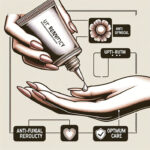Finger Nail Fungus: When It’s Time to See a Professional

Getting to Know Finger Nail Fungus
If you've ever noticed a slight discoloration or rough patch on your fingernail, you might just be dealing with finger nail fungus—a condition that’s more common than you might think and often flies under the radar. While it might seem like a minor skin-deep issue at first, it can quickly evolve into something that not only impacts your appearance but also your overall nail health. In this article, we're going to break down what finger nail fungus really is, what symptoms to keep an eye on, and the various factors that might set you up for it. It’s all about spotting early signs—because catching it early can make all the difference when it comes to treatment and management.
So, What Exactly Is Finger Nail Fungus?
Finger nail fungus, also known medically as onychomycosis, is an infection that takes hold right where you need it least: your nails. This pesky condition is triggered by fungi that love warm, damp spots, so they’re often drawn to your nail bed when conditions are just right. Whether it’s due to a minor injury, less-than-ideal nail hygiene, or even your genetic makeup, there are plenty of reasons why these fungal spores might decide to set up camp. And while it might seem like just a cosmetic nuisance at first, if you let it simmer, it could lead to discomfort or even more serious health issues.
The Usual Suspects: Symptoms and Causes
At first, finger nail fungus doesn't always put up a loud fight. You might only notice a slight tint change or a bit of a texture shift that you chalk up to everyday wear and tear. But if left unchecked, your nails can thicken, distort, and even begin to crumble at the edges. The culprits? Often it’s a mix of living in moist conditions, exposure to fungi in shared spaces, small nail injuries, or even a weaker immune system. Getting to know these subtle clues can really help you nip any potential problems in the bud before they spiral into something bigger.
Nailing Down the Risk Factors
When it comes to the risk factors, it’s not just about one thing—it’s a cocktail of circumstances. Constant exposure to water, especially when you don't dry your hands thoroughly, creates that ideal fungal playground. If you’ve had fungal infections before, or if your immune system isn’t exactly firing on all cylinders, your risk goes up even further. Also, if your daily routine involves environments where fungi run rampant—think public gyms or communal showers—it’s wise to stay alert. And yes, even the way you treat your nails, or rather neglect to, can increase the chances of welcoming an unwanted fungal visitor.
Catching the Early Warning Signs
Being on the lookout for finger nail fungus means paying attention to the little hints your nails drop. The earliest signs are often as subtle as a slight yellowing or browning—nothing too dramatic in the beginning. These small changes, which might only affect one nail at first, are your cue to take a closer look. In many cases, a bit of regular self-inspection can save you from letting the infection put down deeper roots. In short, if you’re in a higher-risk group, making it a habit to check your nails can really pay off.
Mild Discoloration and Texture Tweaks
You might be surprised to learn that one of the first things you could spot is just a minor change in the nail’s color and feel. Think of it as your nail's way of waving a little white flag—a subtle yellow or brown that wasn’t there before, coupled with a slightly uneven or rough texture. Sure, it may seem inconsequential at the start, but it could be the fungus silently settling in. Keeping an eye on these small shifts can help you intervene early, preventing the infection from truly taking hold and sparing you bigger headaches later on.
Nail Thickening and Odd Shaping
As the fungal invasion continues, your nails might start to feel thicker, and you could notice an unusual texture where there once was smoothness. It might even start to crumble or bend a bit. These changes aren’t just about looks—they're a signal that the fungus is messing with your nail’s natural growth. Not everyone will go straight to this stage, but if you do notice these shifts, it’s a sign that the infection is gaining traction, and earlier intervention could make all the difference in avoiding more serious complications.
When Finger Nail Fungus Crosses the Line
There comes a point when what started off as a minor annoyance escalates into a real health concern. This usually happens when the fungus is allowed to run its course unchecked. Before you know it, the infection might burrow deeper into the nail bed and even spread to the skin around it, making treatment much tougher. Lingering fungal infections can lead to persistent discomfort, skin irritations, or even pave the way for secondary bacterial infections. Spotting these warning signs early on and seeking help can prevent a minor cosmetic issue from turning into a major health problem.
Complications Lurking Beneath the Surface
Ignored fungal infections can lead to a whole host of complications. For instance, a weakened nail becomes prone to cracks and breaks, exposing the underlying tissue to further infections. In more extreme cases, you might face a stubborn, painful condition that not only affects your nails but limits your hand’s functionality. And there's always the risk that the fungus could open the door to bacteria—resulting in secondary infections that might require even more intensive care. In short, giving finger nail fungus the time of day isn’t wise; tackling it early can keep extra complications at bay.
Red Flags That Demand Prompt Action
Sometimes, the signs don't just whisper—they shout that it’s time for immediate action. Rapid deterioration of nail quality, noticeable thickening, or severe discoloration covering most of your nail are clear indicators that the infection has stepped up its game. If you also start experiencing pain or if the fungus begins spreading to the skin around your nails, don't wait around; it's time to get a professional on board. Over-the-counter treatments might not cut it at this stage, and dragging your feet could invite more serious issues down the line.
Knowing When to Consult a Professional
Figuring out the right time to reach out to a healthcare provider for finger nail fungus can be a balancing act. While minor changes like slight discoloration might be manageable with home remedies, more persistent or severe symptoms could signal that professional expertise is needed. If the fungus begins affecting multiple nails or if your efforts at home don’t seem to make a dent, it’s a good idea to consult a specialist. Timely professional intervention can help you steer clear of further complications and put you on a faster track to getting those nails back in shape.
Spotting the Persistent Warning Signs
If you’re constantly battling with discoloration, increasingly thick nails, or persistent texture changes that just won’t ease up, these are your nails sending an SOS. When over-the-counter treatments simply don’t seem to do the trick, and you start feeling discomfort or even pain that disrupts your day-to-day activities, it’s definitely time to sit down with a healthcare provider. Ignoring these persistent symptoms can lead to deeper issues, so it’s best to get a professional’s take as soon as you notice that nothing seems to be improving.
Why Early Diagnosis is a Game Changer
Catching finger nail fungus at the earliest stage can really change the game. Early diagnosis makes the entire treatment process a lot smoother and lowers the risk of more serious complications. When you consult a professional right off the bat, they can tailor a treatment plan—be it through medications, topical solutions, or other interventions—that keeps the infection under lock and key. In essence, addressing even a hint of trouble early on sets the stage for a faster recovery and helps you maintain the health and appearance of your nails.
How Finger Nail Fungus is Diagnosed
Diagnosing finger nail fungus is generally a mix of a good old-fashioned visual exam and some lab work to confirm what you're up against. A healthcare provider will typically take a close look at your nails, checking for any signs of discoloration, thickening, or texture changes. In cases where there’s still some uncertainty, they might take a small clipping or scraping of the nail for a mycological analysis, which helps pinpoint the exact type of fungus in action. This combination of hands-on examination and lab confirmation means you get a precise treatment plan, perfectly tailored to your situation.
Taking a Closer Look: Visual Exams and Lab Tests
The first step in diagnosing finger nail fungus is usually a careful visual look at your nails. During this session, your doctor will note any unusual discoloration or texture changes that set your nails apart from their healthy state. If there's a need for more clarity, the next step might involve taking a small sample for lab tests—often a nail clipping or scraping—to see exactly which fungus is playing a role. These lab tests, including fungal cultures and microscopic evaluations, help ensure your treatment strategy is on point and as effective as possible.
When Advanced Imaging Comes Into Play
In those rare, tough-to-treat cases, doctors might turn to advanced imaging techniques. Tools like dermoscopy give a magnified view of your nail’s structure, allowing your healthcare provider to catch even the tiniest changes invisible to the naked eye. Although not always necessary, this deeper look can be a lifesaver when routine treatments haven’t done the trick. Advanced imaging underscores just how important accuracy is when dealing with a stubborn fungal infection, ensuring every detail is carefully considered before moving forward with more aggressive treatments.
Your Treatment Roadmap
There isn’t just one magic bullet for finger nail fungus—there are several treatments available, each tailored to how far along the infection has progressed. Doctors typically turn first to prescription medications, whether you're taking an oral antifungal or applying a topical cream or lacquer directly to the nail. In cases where the infection keeps fighting back, options like laser therapy or even surgical interventions might be on the table. The key is getting a solid diagnosis, so you and your doctor can decide together on the best course to restore your nail health. With the right treatment plan in place, most folks see a real turnaround in both nail appearance and overall comfort.
Prescription Medications and Topical Remedies
When it comes to tackling finger nail fungus, prescription meds are often the go-to solution. Many physicians will recommend oral antifungal drugs that attack the infection from within, while others might prefer topical treatments—like creams or lacquers—that are directly applied to the affected nail. The choice depends on how widespread the infection is, your general health, and even your previous experiences with similar issues. For many, a well-timed prescription can bring rapid relief and significantly reduce the chance of the fungus coming back. Coupled with solid nail care habits, these treatments can help restore both your nail’s look and strength.
Laser Therapy and Surgical Options
For those stubborn cases of finger nail fungus that just don’t seem to budge, laser therapy offers a modern, minimally invasive alternative. This treatment uses focused light to kill fungal cells while sparing the surrounding tissue, and many patients appreciate the minimal downtime it offers. In especially severe cases, when your nail’s structure is seriously compromised, surgical methods might be necessary. Although surgery sounds drastic, it sometimes paves the way for healthier nail growth by removing the problem area entirely. These advanced options highlight just how far modern medical techniques have come, giving you a fighting chance even with the toughest infections.
Keeping Fungus at Bay: Prevention and Long-Term Management
Prevention is really the name of the game when it comes to long-term management of finger nail fungus. Working on effective nail hygiene and making smart lifestyle choices helps cut down your risk dramatically. Think about keeping your hands clean and dry, trimming and filing your nails regularly, and even wearing gloves when you’re handling chemicals or spending time in wet environments. Small tweaks in your daily routine—like being cautious in communal areas—can go a long way toward keeping those pesky fungal spores at bay. A proactive approach now means you’re less likely to deal with recurrent issues later.
Simple Hygiene and Nail Care to Keep You Covered
If there’s one thing to remember, it’s that good hygiene is your best friend when combating finger nail fungus. Washing your hands with a gentle soap, followed by thoroughly drying them (yes, even between your fingers), can make a world of difference. Give your nail clippers and other tools a quick disinfectant wipe after each use, too. Regular nail trimming and filing not only keep your nails looking neat but also prevent any build-up that might invite fungal growth. It’s all about building a daily routine that doubles as your personal defense against infection.
Changing Up Your Lifestyle and Regular Follow-Ups
Managing finger nail fungus over the long haul isn’t just about treating the immediate problem—it’s also about staying on top of preventive measures. This means making lifestyle adjustments, like always keeping your living and workspaces as dry and clean as possible and steering clear of overly moist communal areas. Adding a boost to your immune system through a well-balanced diet might even give you an extra edge. And, of course, regular check-ups with your healthcare provider ensure that once the infection is curbed, it stays that way. A little extra diligence now can keep your nail health in tip-top shape down the road.
Wrapping It Up
Finger nail fungus can start off as a minor annoyance, but if left unchecked, it has the potential to evolve into a much bigger problem. By recognizing early signs like slight discoloration or subtle changes in texture, and understanding the risk factors and complications, you’re better equipped to take control. Whether it's through over-the-counter care coupled with diligent nail hygiene or seeking professional help when necessary, early diagnosis remains key. With the right mix of care and guided treatment—from prescription medications to advanced therapies—you can manage and even overcome this condition. Remember, staying informed and proactive is the best strategy for keeping your nails healthy and fungus-free.





